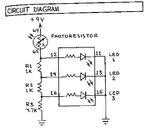ASelis
Newbie level 3
- Joined
- May 6, 2012
- Messages
- 3
- Helped
- 0
- Reputation
- 0
- Reaction score
- 0
- Trophy points
- 1,281
- Location
- Palo Alto, CA
- Activity points
- 1,301
Just started doing hobbyist projects in the last month--building simple circuits--and had a question about this design for an analog light meter:

As light / voltage flowing through the photoresistor increases, it lights LED 1, then 2...
Why does the circuit connect to ground at two points, and how does R3 set a threshold point for successive LEDs to light?
I know this is a simple question--Thanks in advance for replies.
A

As light / voltage flowing through the photoresistor increases, it lights LED 1, then 2...
Why does the circuit connect to ground at two points, and how does R3 set a threshold point for successive LEDs to light?
I know this is a simple question--Thanks in advance for replies.
A